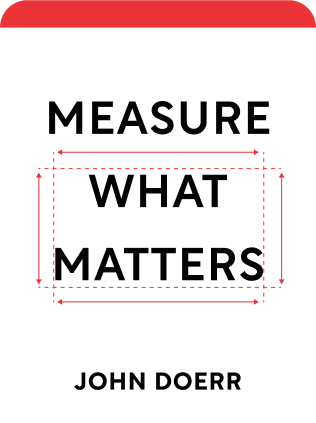

This article is an excerpt from the Shortform summary of "Measure What Matters" by John Doerr. Shortform has the world's best summaries of books you should be reading.
Like this article? Sign up for a free trial here .
What are Google objectives in their OKR system? Should you model your OKRs after Google?
Google objectives focus on stretch goals and more. One of the advantages of Google OKRs is that they’re adjustable. You can see how a Google objective changed in the Google Chrome example below.
Read more about Google objectives, Google OKR examples, and how they led to success.
Google Objectives: Building OKRs
How to Implement OKRs for stretching: Some of your OKRs should be especially challenging. Expect “stretch OKRs” to score between 0.4 and 0.6. Setting challenging goals allows your company to continue innovating.
Google and Stretch Goals
This is how Google distinguishes between regular objectives (“committed objectives”) and stretch objectives (“aspirational objectives”):
- Committed objectives are the goals that need to be met within a set period of time for the company to prosper. Additionally, these goals need to be 100% or near-100% complete (or receive a score of 1.0) by the deadline. Committed objectives include sales and revenue goals around product releases, customer satisfaction, and hiring.
- Aspirational objectives are goals that reflect the bigger picture, outside of day-to-day needs, and focus on big, ambitious ideas. These are often called stretch goals or, in the words of Jim Collins, “Big Hairy Audacious Goals.” (Shortform note: For more on Big Hairy Audacious Goals, read our summary of Collins’s Good to Great.)
Google doesn’t expect everyone to achieve their aspirational Google objectives, and failure is built into the process—in fact, the average rate of failure at Google is about 40%. In other words, Google considers its cycle’s aspirational goals a success if 60% of them are achieved.
Not many companies have Google’s resources, and therefore can’t risk a failure rate that high. Your company’s balance of committed and aspirational objectives will depend on your answers to the following questions:
- Do we want to break into a new market next year? (If yes, favor aspirational objectives, or stretch goals.)
- Do we want to further establish our current position in the market? (If yes, favor committed goals.)
- Do we have some extra cash to play around with? Can we afford to make a risky bet? (If yes, favor stretch goals.)
- Are we in survival mode, just trying to stay afloat? (If yes, favor committed goals.)
- What does our business need from us, right at this moment?
Regardless of your answers, every company should have at least one or two aspirational Google objectives. If your company doesn’t stretch, it won’t be able to compete in the market. The Google OKR system shows how stretch goals can help you be more productive.
Researcher Edwin Locke has found that, generally, the more challenging a goal is to achieve, the higher people perform trying to reach it. In Locke’s study, even though subjects with challenging goals failed more often than subjects with easy goals, the subjects with the hard goals performed at a higher level and achieved more overall. This shows that stretch goals are valuable regardless of whether or not people achieve them, because they inspire employees to work harder.
Tips for Creating Stretch Goals
What not to do if you’re using the Google OKR system:
- Don’t impose stretch goals on your employees without being aware of the realities of their day-to-day work.
- Don’t stretch your team too far, especially employees who are used to achieving 100% on their OKRs. For high achievers, achieving less than 100%, even if it’s expected, can negatively influence morale.
- Don’t set goals that are clearly impossible to achieve. There’s a fine line between aspirational and unrealistic. Aspirational goals inspire employees; unrealistic goals hurt morale.
- Don’t work toward stretch goals with incremental OKRs. OKRs should be exponential, rather than incremental—aim for 300% improvement, not 10%.
What to do:
- Distinguish between committed objectives, goals that must be completed 100% in a certain period of time, and aspirational objectives.
- Convey to employees why the outcome of the stretch goal is important.
- Convey to employees that you believe the stretch goal is attainable.
- Ask: How can our team create the most value possible? What would incredible look like for our company?
Example: Google Chrome
Here’s how the Google OKR system works, using Google OKR examples. In 2006, Google decided to create its own browser, Chrome. In order to achieve their vision, Google’s vice president of product development, Sundar Pichai, had to think big. Browsers were so difficult to make from scratch that there was no point in making one if it wasn’t dramatically better and faster than the browsers already available. Without an enormous goal, the whole endeavor was pointless. Google objectives
A stretch objective needs stretch key results. The main key result was to reach 20 million daily active users by 2008. This is one of the Google OKR examples that shows Google’s stretch goals.
Pichai acknowledged that setting this ambitious goal took courage—Pichai didn’t believe there was any way the team could reach 20 million users by 2008. But he felt he had no other choice—he had to set the bar that high. The only way to create something truly amazing is to set big stretch goals.
The target of 20 million users was relatively arbitrary. So was the target year. In a sense, the numbers didn’t matter, as long as they were wildly ambitious. These numbers made it impossible for Pichai’s team to become complacent. Every day, they had to rethink their process and strategies. The critical thinking and planning skills they developed were almost more important than the Google objectives itself.
Reframing After Failure
Even though the Google objectives didn’t always work, they learned a valuable lesson. As Pichai expected, the team failed to reach its goal of 20 million users by 2008. But they kept moving forward. In 2009, they set the bar even higher, aiming for 50 million active users. When they failed to meet that goal, with 38 million users, they raised the bar again, to 111 million users. They celebrated the fact that 38 million users still beat their original key result of 20 million, and they reframed their failure as a way to figure out what they could do differently the following OKR cycles.
As the 3rd quarter progressed, it looked like they’d fail to meet their OKRs again. Then, they did something simple: they sent alerts to people who’d used Chrome in the past but were not currently active users. Their numbers shot up to 87 million users, then to 107 million, and finally to 111 million daily active users.
Today, there are more than a billion users of Chrome on mobile devices alone. Google got achieved this by setting progressively unrealistic goals that turned out to be realistic after all. They wouldn’t have gotten there if they hadn’t stretched for the impossible.

———End of Preview———
Like what you just read? Read the rest of the world's best summary of John Doerr's "Measure What Matters" at Shortform .
Here's what you'll find in our full Measure What Matters summary :
- How Google uses OKRs to rally 100,000 employees in the right direction
- How to avoid setting useless OKRs, and how to set great ones
- Key subtle behaviors your team must master to make OKRs work






